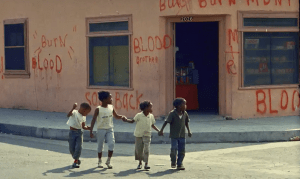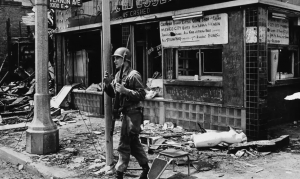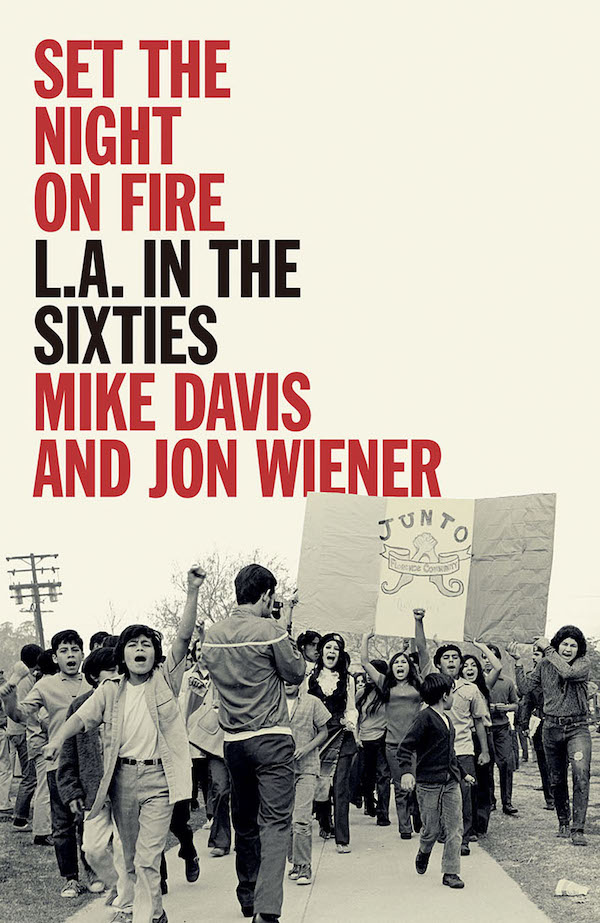In this passionate, lovingly detailed historical account of the struggle for social justice from multiple sectors of society in Los Angeles during an epic American decade, Mike Davis and Jon Wiener have written a history of activists who believed in democracy and demanded justice. It is a brilliant history of sweeping social movements and counterculture that makes earlier narratives of the history of Los Angeles read like glib dramas of white male power and real estate development. With 100 pages of footnotes, Davis and Wiener leave no stone unturned.
Immediately striking is the near-clairvoyant sense of timing. Set the Night on Fire was printed only months before the death of George Floyd on May 25 and the book’s opening chapters explore a level of deeply entrenched racism in Los Angeles that has escaped public perception, which laid the most blame on the American South. The authors make huge strides in adjusting for that misconception.

Riots in Los Angeles, August 1965. Photo by: Bill Ray/The LIFE Picture Collection.
There is a lot here, and what makes it all so inspiring is the way it raises up as history-makers the thousands of forgotten protesters in the ‘60s who broke new ground in multiple arenas. The East LA high school students who successfully organized walkouts to demand community control of education, the ecstatic sense of freedom felt by gay rights activists after the first Pride Parade, the nuns who rebelled against repression in the Catholic Church, the internationally successful Women’s Strike for Peace, the hundreds of teenyboppers who faced billy clubs on Sunset Strip, the young men of all races who refused to go to Vietnam, the immense groundswell of supporters of fugitive Angela Davis, and the tragic demise of the Black Power movement are all brought into the generous light of this illuminating historical text.
What stands out in relief now, after George Floyd, is the meticulously documented account in this volume of how white police in LA repeatedly perpetrated violence against Black and Chicano protestors and murdered them with impunity. The Watts Riots in 1965, that claimed the lives of 35 Black men, by police began when a crowd witnessed 10 cops beating a Black man in handcuffs to a pulp while choke holding a 22-year-old Black woman, as the crowd yelled at them to stop.
A year later a new atrocity set off a “Second Watts.” Just as George Floyd’s murder is emblematic of so many other Black men of our time, Leonard Deadwyler held the same unenviable status in LA’s Black community. On May 7, 1966, while he raced to the hospital with his wife in labor in the back seat, he was pulled over by LAPD for speeding. After Deadwyler asked to be escorted to the hospital, the raging LAPD officer apparently pulled his pistol and shot him through the head in front of his wife, then claimed it was an accident and was released.

Watts riots, August 1965. Photo by: Hulton Archive/Getty Images.
History, once more, has repeated itself and the message implicit in the details of all these beatings and murders of Blacks by the police remains constant: There will be no justice for you because we own you. Set the Night on Fire, among many other things, is a vitally important chapter in our history of racism that has for years, been a looping cycle of violence against Black Americans.
This grotesque hatefulness is intricately linked to serious challenges to our survival as a sovereign nation: massive environmental destruction, a racist, incompetent president, severe income inequality, a mismanaged racially targeted pandemic, decay of public education, corporate profiteering in government and health care and the militarization of the police.
A pressing need for change grows daily and it is inconceivable that this level of change will come about by voting alone; it will take protest, rebellion and disobedience. Set the Night on Fire appeared at the right moment to become a consciousness-raising reference manual sorely needed for everything that is coming. Let it be that for you.


